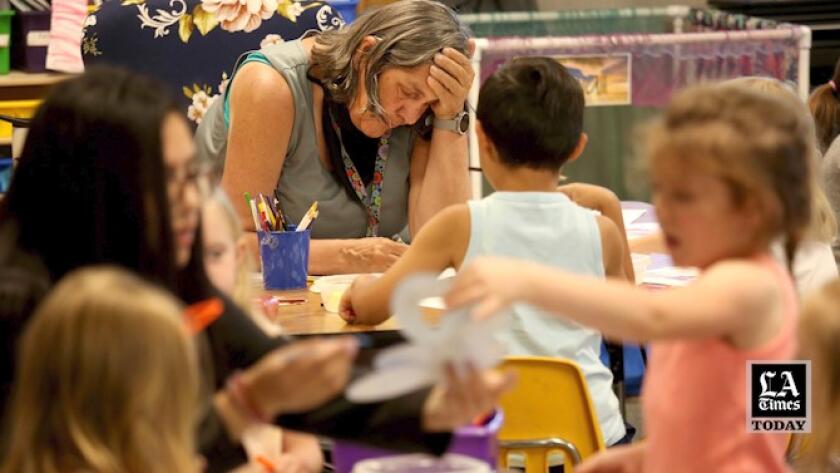
- Share via
ALTURAS, Calif. — The new kindergarten teacher resigned via email on a Sunday night in February.
It didn’t matter that 18 children would show up in her classroom the next morning. She said she was done. Effective immediately.
Administrators at Alturas Elementary School were forced to scramble. They found a substitute teacher for that first day — a small miracle, given there are so few in rural Modoc County.
Then they divvied up the 5- and 6-year-olds.
Half were split among the remaining two kindergarten teachers, who already had about 20 kids each. The other nine students went to the transitional kindergarten classroom, where they would learn with younger students, sometimes breaking off for more advanced lessons.
“It’s not perfect, but it’s what we had to do,” Principal Beckie Lewis said. “We had nobody to fill that spot.”
In this occasional series, we explore rural, conservative California through its struggling schools, which are cornerstones of life in small towns.
Four rural Northern California school superintendents went to Washington to look their legislators in the eye and tell them just how desperate they are.
“Not perfect” is the name of the game in classrooms across California.
Even the state’s largest public school districts, like Los Angeles Unified, which lists more than 450 teacher vacancies for the coming academic year, struggle to find credentialed instructors and keep class sizes down.
In small, rural districts like Modoc Joint Unified in Alturas, a cattle ranching town of 2,700, being short even a few teachers can send a school spiraling.
At Alturas Elementary School, there are six vacancies — a quarter of the teaching staff.
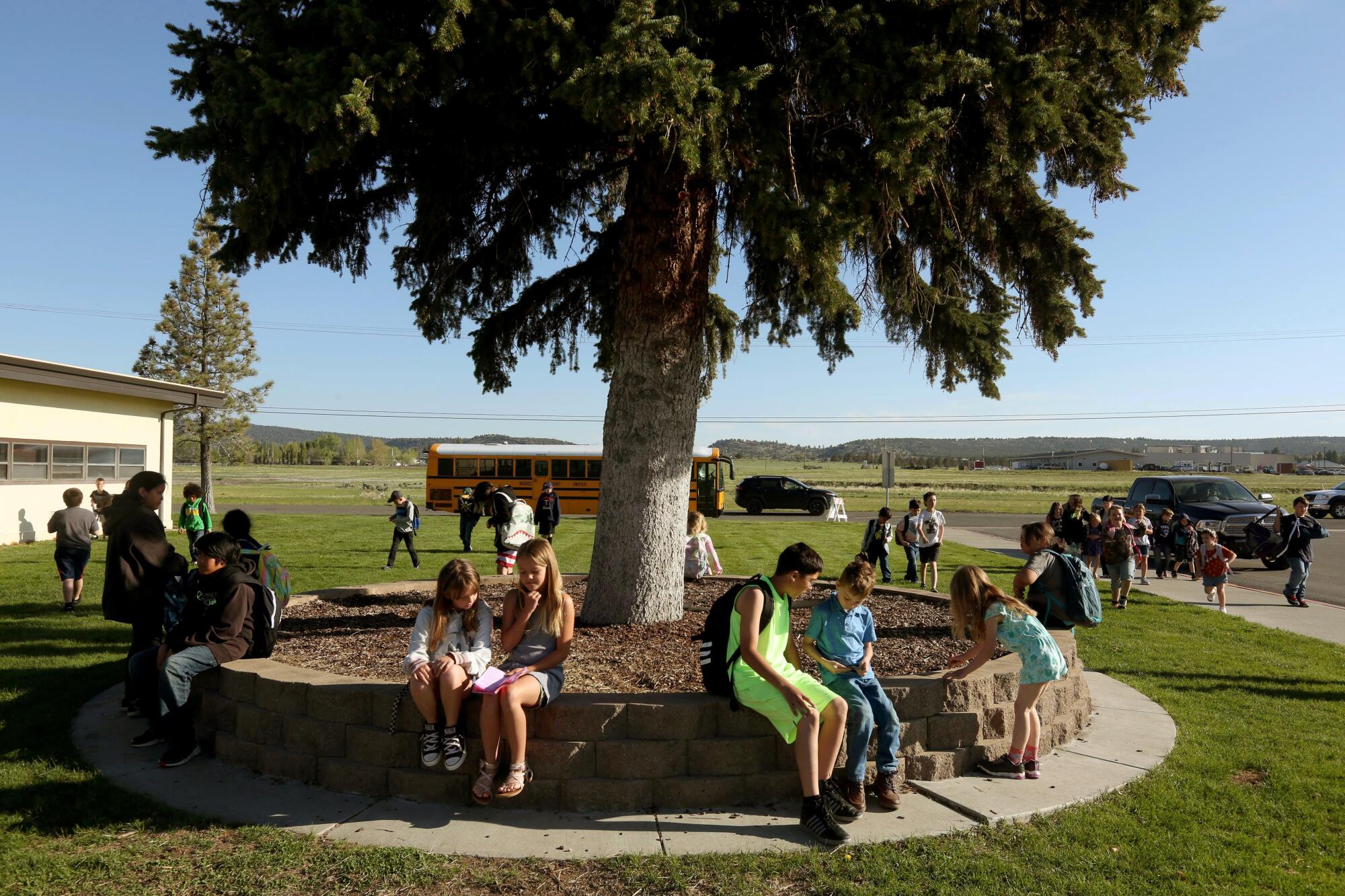

It has become so difficult to hire and retain educators that administrators have attended hiring fairs not just across California, but also in Montana, Nevada, New Mexico and Oregon.
They tried going to North Dakota this year, figuring they could attract small-town folks who might prefer the slightly warmer Northern California winters. They made it all the way to Denver but had to turn back — it had snowed too hard, and their connecting flight was canceled.
All of the out-of-state travel has yielded zero qualified applicants.
The teacher shortage is so dire that administrators say they have no choice but to violate a new state law that will require public school districts to soon offer free TK — an additional year of instruction that precedes kindergarten — to all 4-year-olds.
The district, which had a single TK teacher, is scrapping the grade level altogether.
To recruit teachers, school officials try to sell the perks of rural life: The slower pace. The deer that walk right along Main Street. The postcard-pretty sunrises over the Warner Mountains. Low crime and so little traffic that there is only one stoplight in the whole county.
But they don’t sugarcoat the isolation. When they interview job candidates, they note: Alturas is 100 miles from the nearest Walmart, across the state line in Klamath Falls, Ore.
“We don’t want to lie to somebody and tell them we have stuff we don’t have and they get here and they’re miserable,” said Brian Norby, the outgoing principal at Modoc High School, who recently went on a fruitless recruiting trip to the University of Montana.

People in California’s rural north feel as if this famously liberal state is leaving them behind — a feeling of alienation that has long fueled the region’s conservative politics.
The population is dwindling. Wildfires are getting worse. Law enforcement agencies are woefully understaffed. Hospitals are few and far between.
The state’s move to ban the sale of new gas-powered cars by 2035 is, to many residents, laughable in a vast region with few electric vehicle chargers, where people drive farther and, often, over mountain passes. Like universal TK, it feels like an edict from lawmakers who don’t understand the challenges of rural life.


Modoc County is larger than the states of Delaware and Rhode Island combined, but it is home to just 8,500 residents. It is one of California’s poorest counties, with a fifth of the population living in poverty.
The last major sawmills closed three decades ago, and the region never really bounced back.
Though many people struggle, it is a place of great beauty that inspires a fierce loyalty.
“It’s a great little community,” Norby said. “It’s where everybody knows everybody. We know our kids by name.”
Norby, a 50-year-old grandfather of five, worked at the high school for 12 years. He left his job this summer to be the superintendent in Tulelake, a small town 70 miles northwest. It was a career change he decided on after an emergency surgery this spring to repair an intestinal obstruction. The health scare was a wake-up call: If he ever wanted to be a superintendent, he figured, he should do it now.
The assistant principal will take his job. That, of course, leaves an opening for assistant principal.
Of 30 staff members on the high school campus, Norby hired all but three. Most are young out-of-towners from across California. Norby’s pitch: Come to a small school, where you have fewer students and get to know them better.
Teachers in the district make good money: between $53,000 to $100,500 in a county where the typical home price in May was the lowest in California, at about $189,000, according to Zillow.

But in recent years, waves of retirements and resignations — typically younger teachers who have children and want to move closer to family — have made filling staff openings a constant struggle.
Teacher shortages are a nationwide problem that researchers attribute to low pay, a perceived lack of respect for the profession, burnout exacerbated by the COVID-19 pandemic, and a highly charged political environment thrusting schools center stage in the nation’s culture wars, from book bans to discussions about race, gender and sexuality.
In California, there were more than 10,000 teacher vacancies — including positions filled by people who do not hold credentials — during the 2021-22 school year, according to the state’s Department of Education.
Alturas’ plight is common to small towns throughout the U.S. Recruitment is hindered by geographic isolation, inadequate housing and the widespread expectation that educators will teach multiple subjects rather than specialize in, say, math, said Kari Oyen, a University of South Dakota professor of school psychology who has studied the teacher shortage in rural America.
In such areas, she said, the best candidates often are those who grew up there, have family connections and love the place, warts and all.
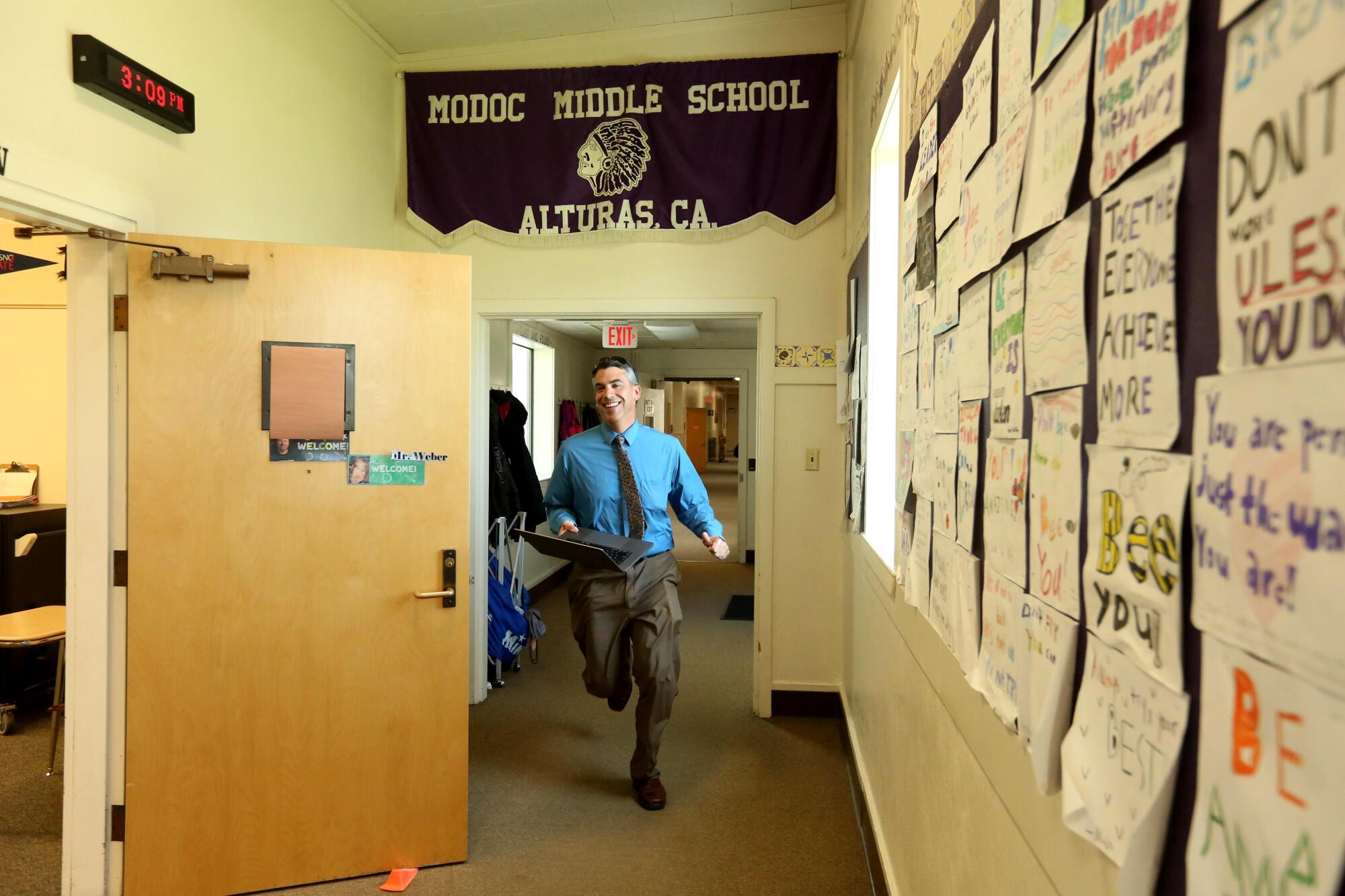
Like Modoc Joint Unified Supt. Tom O’Malley.
A lanky 54-year-old with a quick smile and easy laugh, O’Malley graduated from Modoc High and raised two kids in Alturas. His parents lived here. His grandparents, too.
O’Malley, who also is a volunteer firefighter, is generally upbeat. But plugging holes in a dam year after year to keep schools staffed has worn him down.
In May, O’Malley wrote a letter to local families, laying out the district’s struggle to staff transitional kindergarten.
“One thing has become clear in our search for employees — no one is coming to our rescue,” he wrote. “Let’s be honest. Our geography is not attractive to many folks.”
The COVID-19 pandemic unexpectedly saved one of the smallest public schools in California, even as enrollment is plummeting elsewhere.
On one side of his office — in the 1930 Spanish Colonial Revival building that houses the middle school — is a banner reading: “All that is necessary for the triumph of evil is for good men to do nothing.”
On the other side: a list of staff openings scrawled on the dry erase board.
Two years ago, during the height of the pandemic, the district couldn’t find a math teacher. So O’Malley taught high school trigonometry himself. He and his principals regularly fill in as substitutes.
Last fall, a fourth-grade teacher quit mid-semester, forcing a colleague who had just started a new Science, Technology, Engineering and Math class to abandon it and fill the vacancy. Next year, fifth grade will be pared down, from three teachers to two, meaning there will be more students per class.
O’Malley persuaded a retiree to un-retire last year and teach special education half time. But she is not coming back.
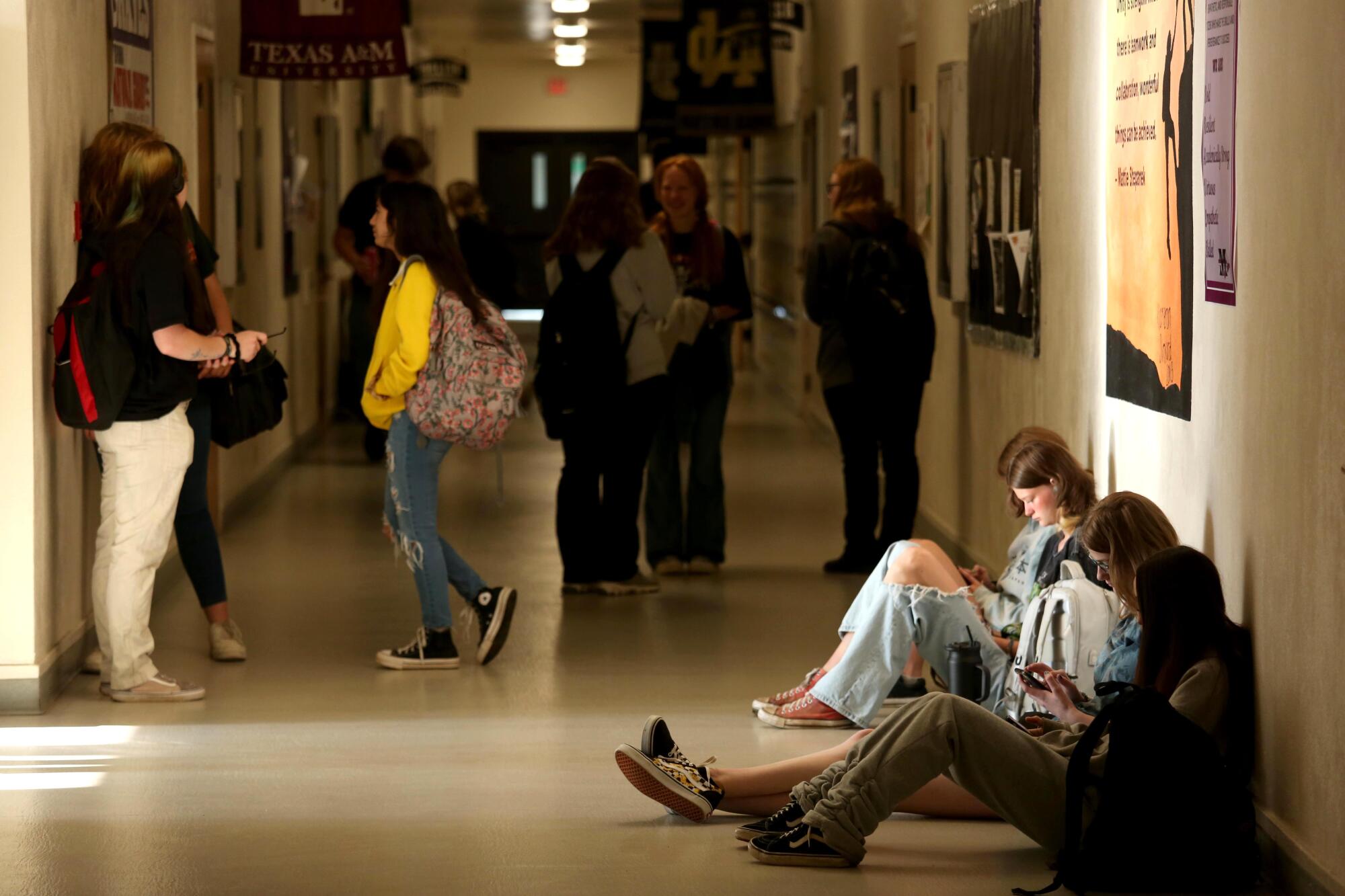
Allison Ashley, 26, who just wrapped up her third year of teaching fourth grade, won’t be coming back, either.
School administrators recruited Ashley — who grew up in the tiny town of Chester, 140 miles southwest — at a job fair at Chico State. She moved to Alturas, where she bought a house, for her first teaching job.
Although she and her husband, a firefighter for the California Department of Forestry and Fire Protection, had no family there, they felt as though the townsfolk wrapped their arms around them.
“Alturas is a really good place when you’re a brand-new teacher,” she said. “It is so supportive. The cost of living is so cheap; the pay is good. Then you realize you’re in the middle of nowhere.”
In December, Ashley, pregnant with her first child, was teaching when her water broke. Her husband was hours away, working out of cellphone range.
So the school nurse drove her, through a snowstorm, two hours south to the hospital in Susanville as she timed her contractions in the passenger seat.
With her husband gone several days a week, Ashley needed help with her son, Brayden. After the school year ended, the couple moved back to the Chester area, near family, she said in an interview in July as she was unloading a U-Haul.
When she turned in her resignation letter to Principal Lewis, she wept. When O’Malley, in her exit interview, asked if there was anything they could do to keep her, she replied: “If you move my family here, I will never leave.”
She loves the district so much that she signed up to be a substitute teacher. On her husband’s off days, she plans to drive two hours north to help.
And then there’s transitional kindergarten.
Two years ago, Gov. Gavin Newsom announced a plan to massively expand TK, creating an additional year of free public education for some of California’s youngest children.
Over the last decade, most districts, including Modoc Joint Unified, have offered limited TK programs, open only to children whose 5th birthday fell just after the kindergarten eligibility cut-off date.
Under the new law, eligibility expands annually until the 2025-26 school year, when every 4-year-old in the state will be entitled to a seat.
Statewide, schools will need to hire 11,900 to 15,600 new credentialed TK teachers by then, according to the Palo Alto-based Learning Policy Institute.
Beginning in 2025, the state also will require additional credentials — such as college credits in early childhood education — to teach TK, further narrowing the pool of educators.
That is an obstacle in vast Modoc County, which has no university or community college and few college graduates.
As California expands access to transitional kindergarten for all 4-year-olds, districts across the state struggle to recruit and accommodate young learners.
TK classrooms also will need more instructional aides, with a state requirement of one adult for every 12 children tightening to one adult for every 10 students by 2025.
State funding is tied to student average daily attendance, so Modoc Joint Unified would draw in more money if it offered an expanded TK program — but it can’t, without more teachers.
The school district is one of the most geographically expansive in the state, stretching 72 miles from northern Lassen County to the Oregon border.
As in financially strapped rural districts across the country, declining enrollment at some of its most far-flung campuses has triggered a death spiral. In recent years, elementary schools in Canby, Likely and New Pine Creek have closed, leaving children to board buses earlier and travel farther to school. Alturas is now the only elementary school in the district.
Even with fewer students, there are not enough teachers.
On a frigid Tuesday night in March, a heavy snow fell as the Modoc Joint Unified school board discussed the staffing dilemma with just one parent in the audience.

In Alturas, O’Malley told the board, each grade level consistently has 60 to 70 students. To run an expanded full-day TK program requires three new teachers to comply with state-mandated student-teacher ratios.
The district has tried hard to recruit for those positions. There have been no takers.
Principal Lewis said staffers at the elementary school have merged and consolidated programs and classrooms, shared aides and scrambled when there are no substitute teachers.

“We’ve been creative,” she said. “But we’re going to run out of manpower before we run out of creativity. I mean, we’re trying, but we’re strapped.”
With current staffing, O’Malley said, the options after the TK expansion are to put 60 or so children in a classroom — or to just not offer TK.
A spokesman said the California Department of Education is “aware of the additional challenges rural districts face when it comes to TK enrollment, including adequate classroom space and staffing shortages” that were “exacerbated by the COVID-19 pandemic.”
But, the spokesman, Brody Fernandez, said in an email, “It is the California Department of Education’s position that all public school districts in California must offer Transitional Kindergarten to all age-eligible children.”
It remains unclear what will happen to school districts that fail to offer the program. Fernandez said his department does not have the authority to issue a penalty.
O’Malley told The Times he can’t help but feel a little bitter toward policymakers in Sacramento, who “don’t know what’s going on in the field — especially in rural California.”
“When I don’t have a choice, and to do the right thing for my students, I have to break a law — that’s obviously not sound policy,” he said.
At Modoc Joint Unified, Laurel Rulison was the only instructor credentialed to teach TK during the last school year.
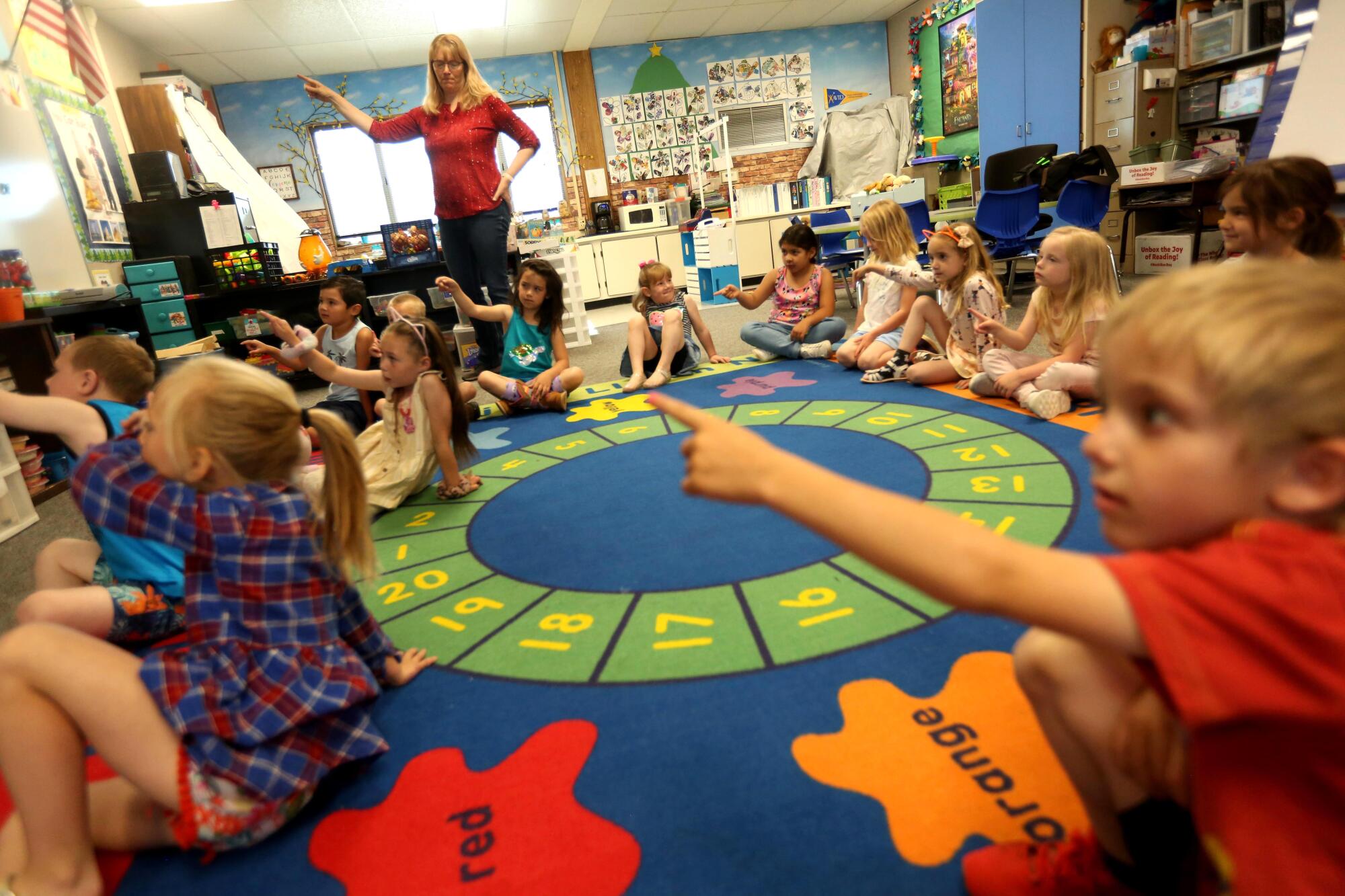
Rulison, 46, describes herself as a “rug teacher” who spends her days at eye-level with her young students, sitting criss-cross applesauce on a big blue carpet decorated with numbers and letters.
Rulison grew up in Ventura County, followed her college sweetheart — now her husband — to Modoc County when she was 24 and has been teaching in the district ever since. Her husband works on his family’s ranch.
Rulison, who is raising two children here, treasures long after-school walks with the elementary school music teacher and his wife — and four dogs — along quiet dirt roads where they search for shiny black obsidian and ruminate about their day.
She has been teaching TK for four years. When the academic year started last August, she had two half-day classes.
Then, in February, after the kindergarten teacher quit, Rulison suddenly was “gifted with nine kindergartners,” as she puts it.
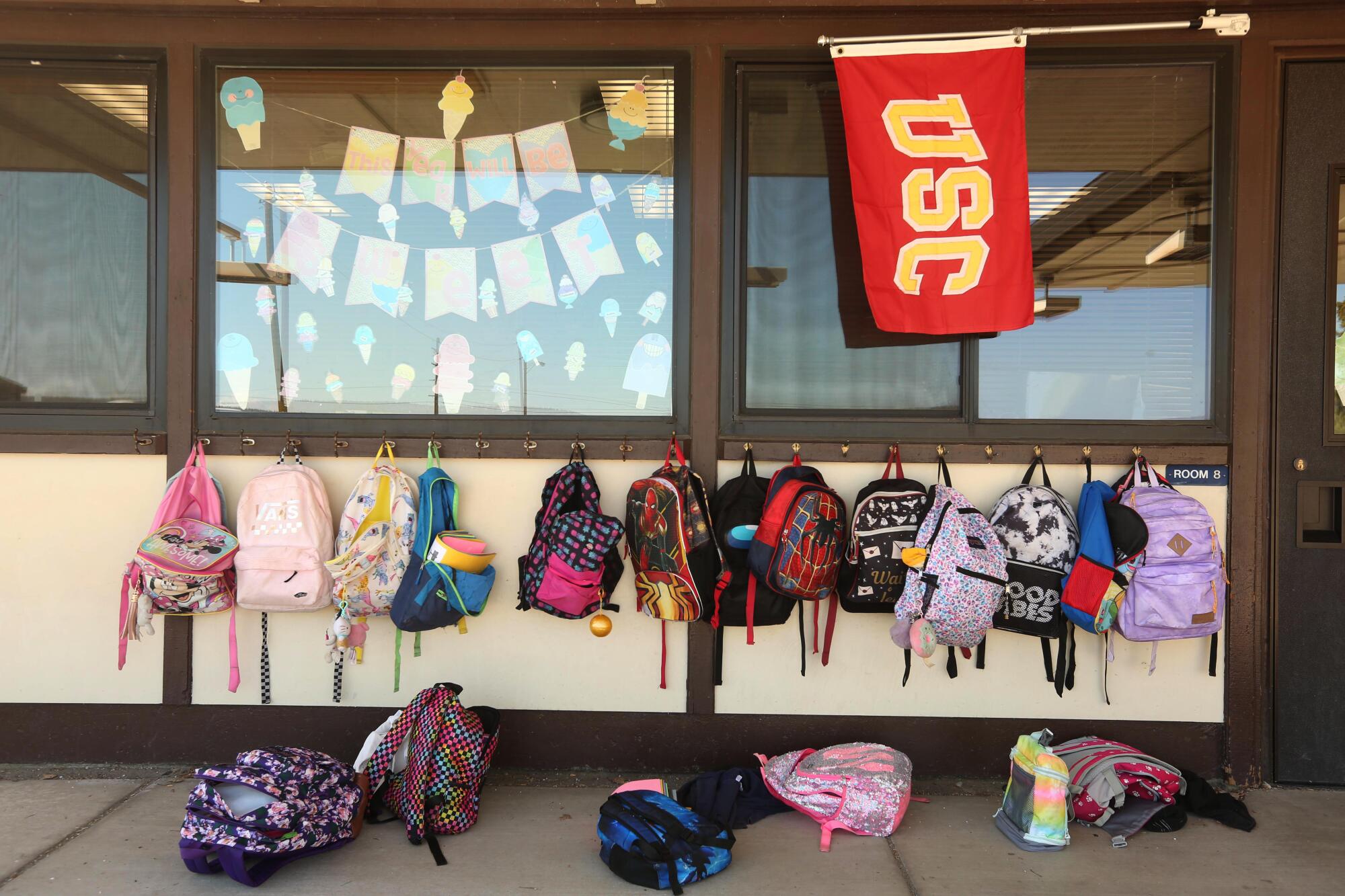
“If I had been really upset about the changes — and, of course, I was in my heart — they pick up on that energy,” she said. “Those kindergartners ... needed to know that they were safe and they were welcome. I had to put all the frustration aside and compartmentalize it.”
Attempts by The Times to reach the teacher who quit — who had moved from Montana and was in her first year — were unsuccessful. Administrators said they were not allowed to discuss the reasons for her departure.
For Rulison, gaining a cohort of kindergartners turned her days into a juggling act. She had a morning TK class with 11 students. An afternoon TK class with six. And the nine full-day kindergartners spanned the gap.
To make it all work, Rulison split the day into 15- to 20-minute segments.
The morning after the March school board meeting, Rulison was still getting used to the chaotic new routine.
The children started filtering in just after 8 a.m., playing in reading nooks with tiny couches and bean bags and a kitchen area with toy food and a hand-painted sign that read: Snowbucks.
Rulison led them in taking a deep breath to start the day. They did a chant to remember the new routine, with the morning TK class leaving midday before the afternoon class arrived.
“After recess?” Rulison asked the children.
“We go our separate ways!” they shouted back.
“Except for?” she asked.
“Kindergarten! They stay all day!”
By 9:07 a.m., Rulison was reading a book called “Plants Are Living Things.”
By 9:13 a.m., the class had split up. Rulison took the kindergartners to a table to practice writing letters and asked them to draw pictures of things that make them feel lucky. One boy drew Chuck-E-Cheese; another, his mom, dad and sister.
The TK kids went to another table with instructional aide Eleanor Dorton to make shamrock crafts with pipe cleaners and beads. Dorton, 65, had been working with first-, second- and third-graders, but Rulison said she “stole” her when she inherited the kindergartners.
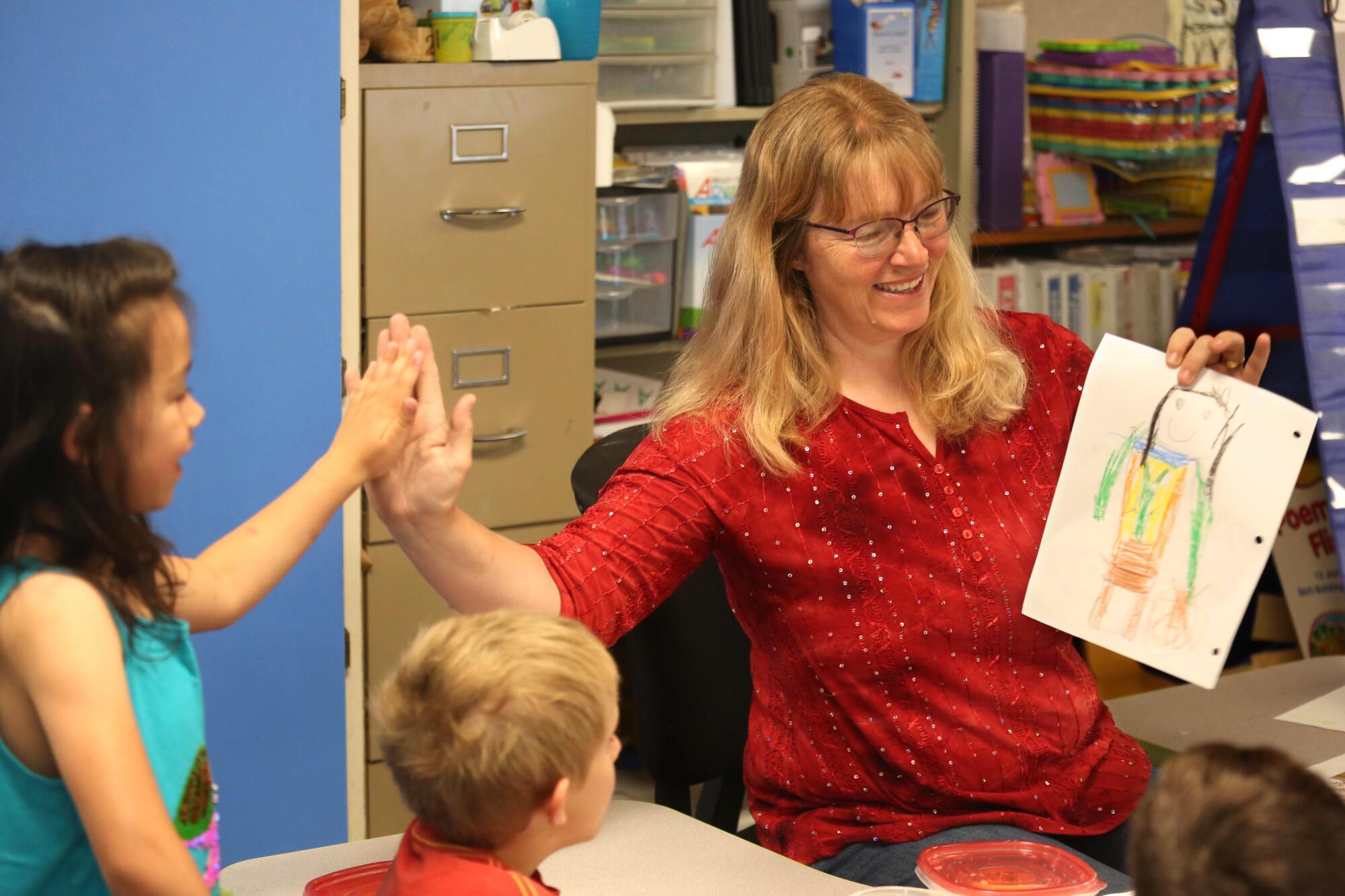
The children rotated among what Rulison called “centers” — some doing handwriting exercises, some reading, some assembling puzzles and some playing educational games on Chromebooks.
Rulison constantly eyeballed a big digital clock with glowing red numbers.
Amid the shuffling were small moments of grace. At the TK table, a tiny girl told Dorton: “Everybody calls me annoying.”
Dorton, a stout woman with a quiet demeanor and gentle manner, smiled. “You know what? We can all be annoying sometimes,” she told the girl, who grinned and nodded.
By 9:46, the kids lined up for recess, grabbing thick coats from their cubbies. Outside, it was 28 degrees — a classic, long Modoc County cold snap, with snowy days stretching well into spring. The children played until they were sweaty.
The 15-minute break was just enough time for Rulison “to go to the potty and drink more coffee.”
Working with small children, who will cry one moment and hug you the next, is demanding, physically and emotionally. A single child acting out can take up much of the teacher’s attention.
Before 11 a.m., one boy had a meltdown, tried to take other kids’ Play-Doh and threw his body to the floor. He tried to pull Dorton down, but she got on her knees, eye-level with him, and rubbed his back until he calmed down.

“Be a good friend,” she told him softly.
At 11:40 a.m., the morning TK class went home. A new class arrived. The kindergartners remained.
One skinny brunette girl, wearing a headband with kitty cat ears, thought she had been demoted back to TK.
“I was in kindergarten, but now I’m over here. My teacher quitted,” she told a Times reporter visiting the classroom.
By the next month, the district had decided to scrap its TK program altogether. In the fall, Rulison will teach kindergarten full time to replace the teacher who quit.
Rulison hopes the children — many of whose families struggle with poverty — are learning, since their time is so short.
“At the end of the day,” she said with a sigh, “I feel like my job is just to love them.”
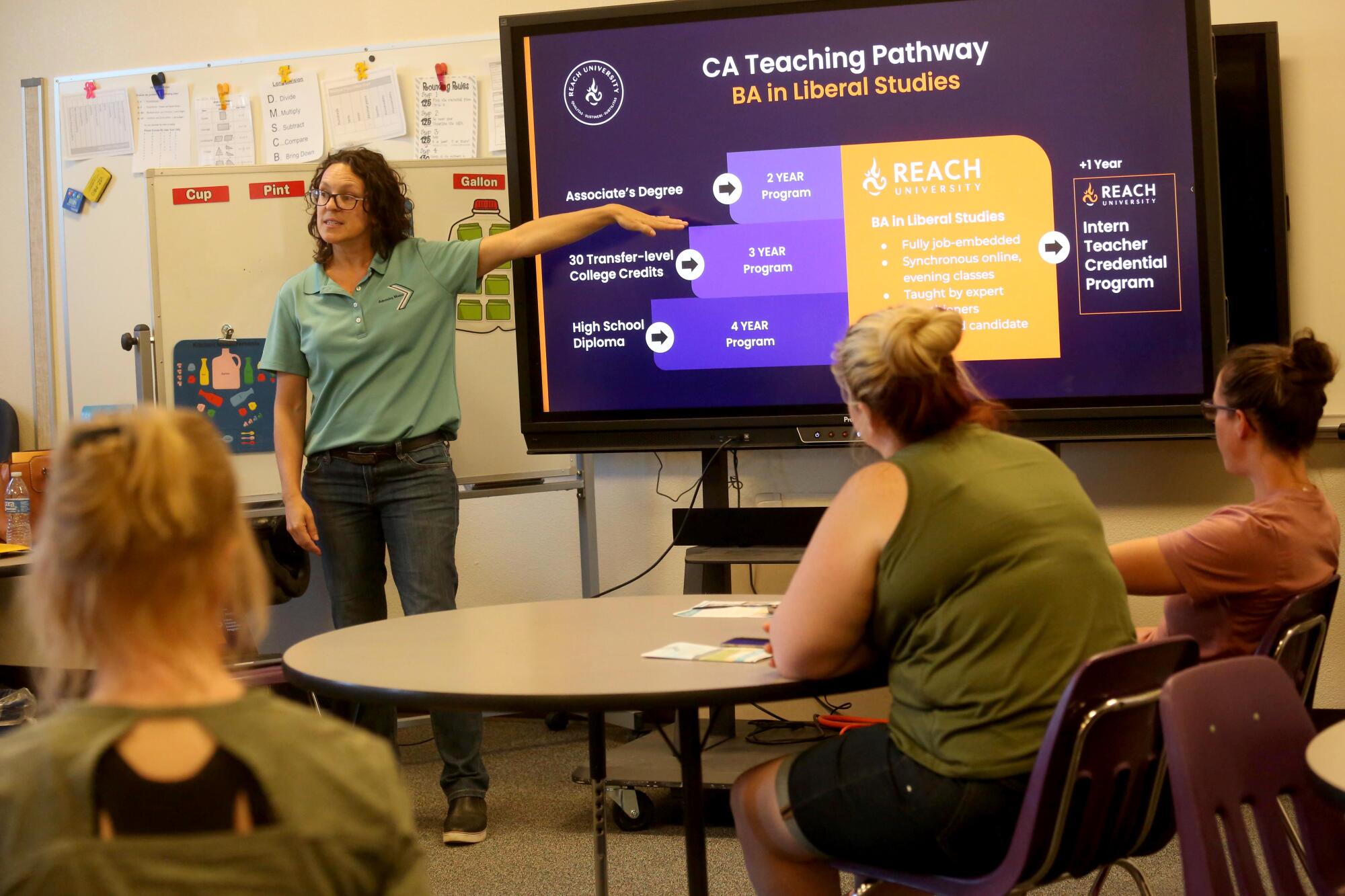
On a Thursday afternoon in mid-May, 15 people filed into a classroom at Modoc Middle School to hear Tanja Ramming speak about how to earn a bachelor’s degree and teaching credential online.
Ramming, director of Advancing Modoc, a nonprofit that works to increase educational opportunities in the region, said plenty of locals, including paraprofessionals already working in classrooms, would love to become credentialed teachers.
But that requires a bachelor’s degree — a barrier in a county where just 20% of residents 25 and older have one, compared with 35% statewide.
The nearest California public four-year university is Chico State, four hours southwest.
Ramming pitched an online program through the private Reach University. Someone employed at a K-12 school, preschool or day care can earn a bachelor’s degree and teaching credential through night classes, with their jobs counting for credit. Modoc Joint Unified partnered with the university for a state-funded grant — so the program is free for district employees.
“I heard about the shortage, and I’m like — you know what? I’m going to see if they need any extra help,” said Brooklyn Sims, 30, who was born and raised in Modoc County and has children ages 6 and 10. She works as an in-home supportive services provider but recently lost hours.
“I would probably really like being a TK teacher,” said Sims, who volunteers at the school and whose daughter was in Rulison’s TK class. “I love the littles.”
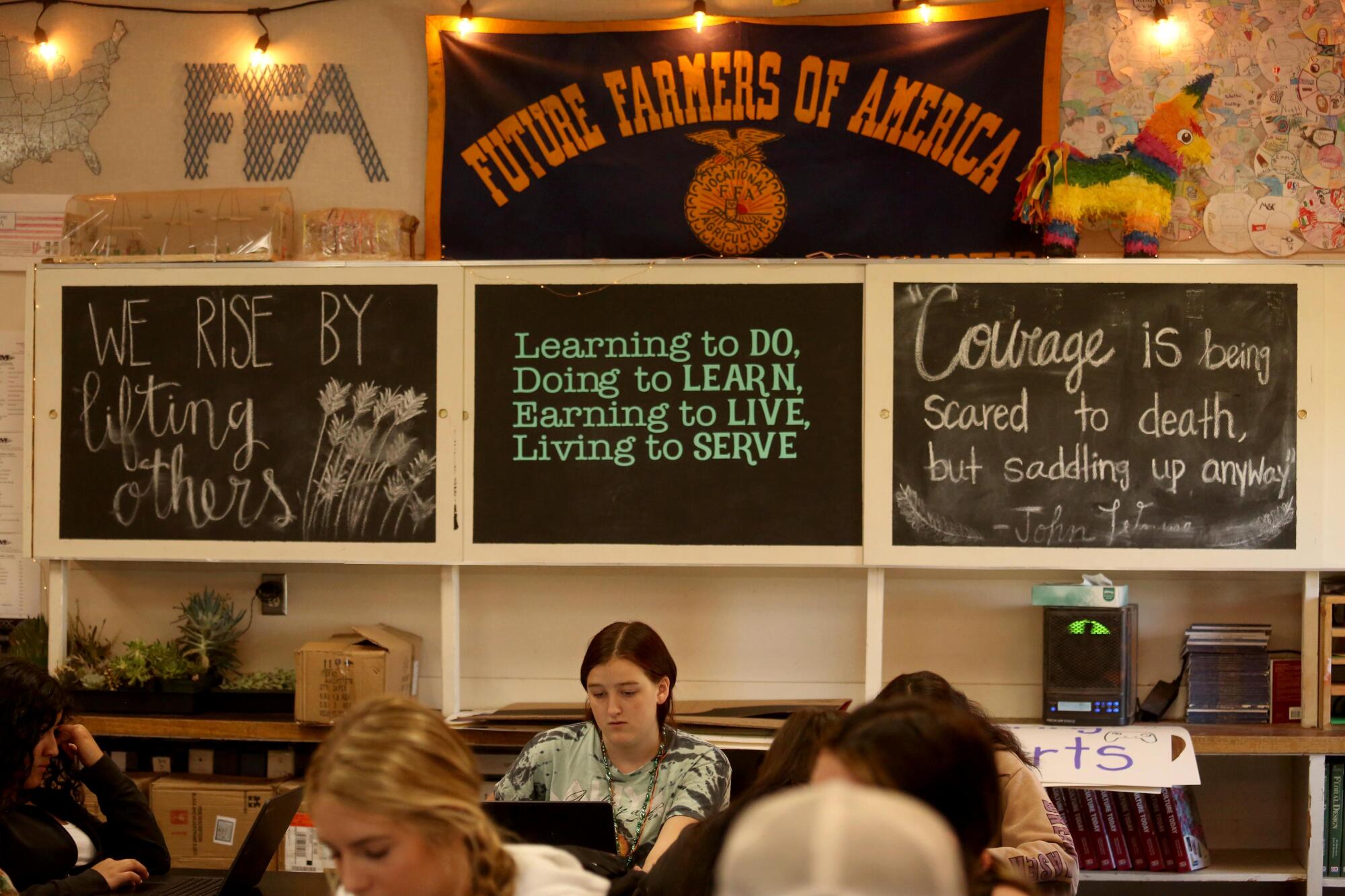
Dorton also was in the audience.
She started teaching preschool — which does not have the same credentialing requirements as public TK — in 1984. She also managed the local swimming pool for 32 years, teaching lifeguarding and water safety.
She would make more money as a fully credentialed teacher. But she doesn’t have her bachelor’s degree — or much spare time. She is raising her two great-nephews alone.
“I wanted to see what it would take for me to go ahead and teach. Probably at this point in my life, it doesn’t make sense,” she said.
In late May, just before graduation for the Modoc High Class of 2023, O’Malley got some bad news.
One of his new hires — a middle school English teacher from Nevada — had backed out. She said she couldn’t find adequate housing.
O’Malley would add the opening to the ever-growing list.

- Share via
Watch L.A. Times Today at 7 p.m. on Spectrum News 1 on Channel 1 or live stream on the Spectrum News App. Palos Verdes Peninsula and Orange County viewers can watch on Cox Systems on channel 99.
More to Read
Sign up for Essential California
The most important California stories and recommendations in your inbox every morning.
You may occasionally receive promotional content from the Los Angeles Times.




